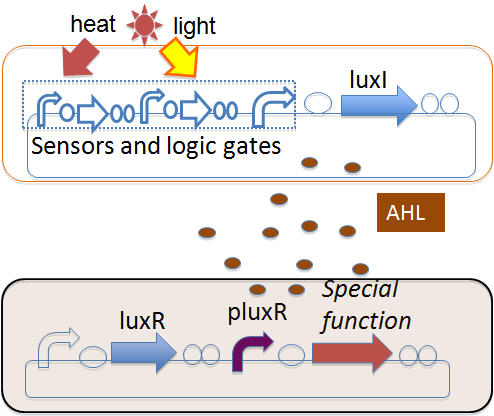Team:Tokyo Tech/Consortium
From 2009.igem.org
| Main | Team | Terraforming | Experiments | [http://partsregistry.org/cgi/partsdb/pgroup.cgi?pgroup=iGEM2009&group=Tokyo_Tech Parts] | Safety |
Contents |
What’s Microbial consortium?
Microbial consortium is a group of different species of microorganisms that are interacting with each other. For instance, there are predator-prey interactions, communications and so on.
Why do we need Microbial consortium?
In Mars, as described above
Link
,there are much carbon dioxide and carbonate deposition. But there is little amount of organic matter. So, heterotrophic microorganism like E.coli cannot survive on its own. That's why autotrophic microorganisms are needed for the production of organic compounds in early stage of terra-forming.
However, Surviving harsh Martian conditions, bacteria should be adapted to a little change of environment. Therefore, we have to introduce various sensing elements to bacteria. For example temperature sensor, light sensor, pH sensor and so on. But it is difficult to introduce intricate genetic circuitry to unconventional heterotrophic microorganism, even intricate genetic circuitry can introduce to experimental E.coli easily.
The solution is division of work.
E.coli have signaling devices regulated by sensors and logic gates. Meanwhile, specialized bacteria have outputs generator that is activated by signals. Microbial consortium provides simple genetic circuit for specialized bacteria, so we can overcome difficulty of genes introduction to specialized bacteria.
Temperature regulated luxI
We constructed plasmid that contains temperature-regulated luxI as a key signaling device.
This system uses a temperature sensitive variant of cI lambda repressor to regulate the lambda promoter. E.coli N4830 strain expresses temperature-sensitive cI protein constitutively.
Temperature sensing of lambda promoter
BBa_K19300(pL-GFP) BBa_I763007(Bologna07,pL-mRFP)
[fig]
We confirmed the temperature-regulated function of lambda promoter.
We introduced GFP or mRFP reporter regulated by cI to E.coli N4830 strain expressing temperature-sensitive cI protein. E.coli express GFP or mRFP at 37℃, but don’t at 27℃. This result suggests that the lambda promoter works and regulates GFP or mRFP expression.
Proof of temperature sensing of lux signaling
BBa_K19301(pL-luxI) BBa_J54140(luxR,Tokyo_Alliance06)
[fig]
We applied luxI signaling to temperature-regulated system. We introduced luxI signaling device and GFP reporter to E.coli N4830 strain expressing temperature-sensitive cI protein. In this system, if E.coli produce AHL under conditions of high temperature, E.coli express GFP.
We can expect E.coli express GFP at 37℃, but don’t at 27℃. This result suggests that E.coli express luxI at 37℃, but don’t at 27℃. And signaling device works and regulates by temperature.
Assay
To quantitatively determine the performances of sensor parts in the receiver plasmid, the change of fluorescence intensities of the receiver strains in the change of were measured.
- Dilute overnight cultures of E.coli strains grown at 37℃ in LB medium containing appropriate antibiotics 1:100 in LB medium.(prepare 2 fresh cultures in each sample)
- Incubate at 37℃ or 27℃ as fresh cultures for 6 hours
- Take 1 ml of each culture to 2 ml tube and wash it.
- Take 200 μl of the washed culture to 96-well plate and measure its fluorescence intensity by Fluor meter (FLA).
- experiment3: After their OD600 reach 0.2, add 0.25 μM AHL 6 μl (only a strain, transformed with PtetR-luxR-TT-PluxR-luxR-GFP,AHL+)
Wash
- Centrifuge for 1 min at 9000 rpm.
- Discard the supernatant with a pipette.
- Dissolve the pellet at the bottom of the tube in PBS to dilute samples to OD=0.8.
experiment1 pL-GFP temperature-regulated assay
The measured fluorescence intensity was corrected by subtracting the background fluorescence, measured in control wells containing 200 μl of PBS. The corrected value was normalized to culture volume and OD600 and expressed in fluorescence per (ml x OD600). A strain, transformed with PtetR-GFP, which expresses GFP constitutively, was used as a positive control. A strain, transformed with PlacIq -melA, which does not express GFP was used as a negative control.
experiment2 pL-mRFP temperature-regulated assay
The measured fluorescence intensity was corrected by subtracting the background fluorescence, measured in control wells containing 200 μl of PBS. The corrected value was normalized to culture volume and OD600 and expressed in fluorescence per (ml x OD600). A strain, transformed with PtetR-mRFP, which expresses RFP constitutively, was used as a positive control. A strain, transformed with promoterlessRBS-GFP, which does not express mRFP was used as a negative control.
experiment3 pL-luxI temperature-regulated assay
The measured fluorescence intensity was corrected by subtracting the background fluorescence, measured in control wells containing 200 μl of PBS. The corrected value was normalized to culture volume and OD600 and expressed in fluorescence per (ml x OD600). A strain, transformed with PtetR-GFP, which expresses GFP constitutively, was used as a positive control. A strain, transformed with PtetR-luxR-TT-PluxR-luxR-GFP(AHL+), which expresses GFP, was used as a positive control. A strain, transformed with PtetR-luxR-TT-PluxR-luxR-GFP(AHL-), which does not expresses GFP, was used as a negative control. A strain, transformed with PlacIq-melA, which does not express GFP was used as a negative control.
We confirmed that the part pL-mRFP (Bologna07), which did not use as a temperature–regulated system before, could use also for this system.
 "
"

